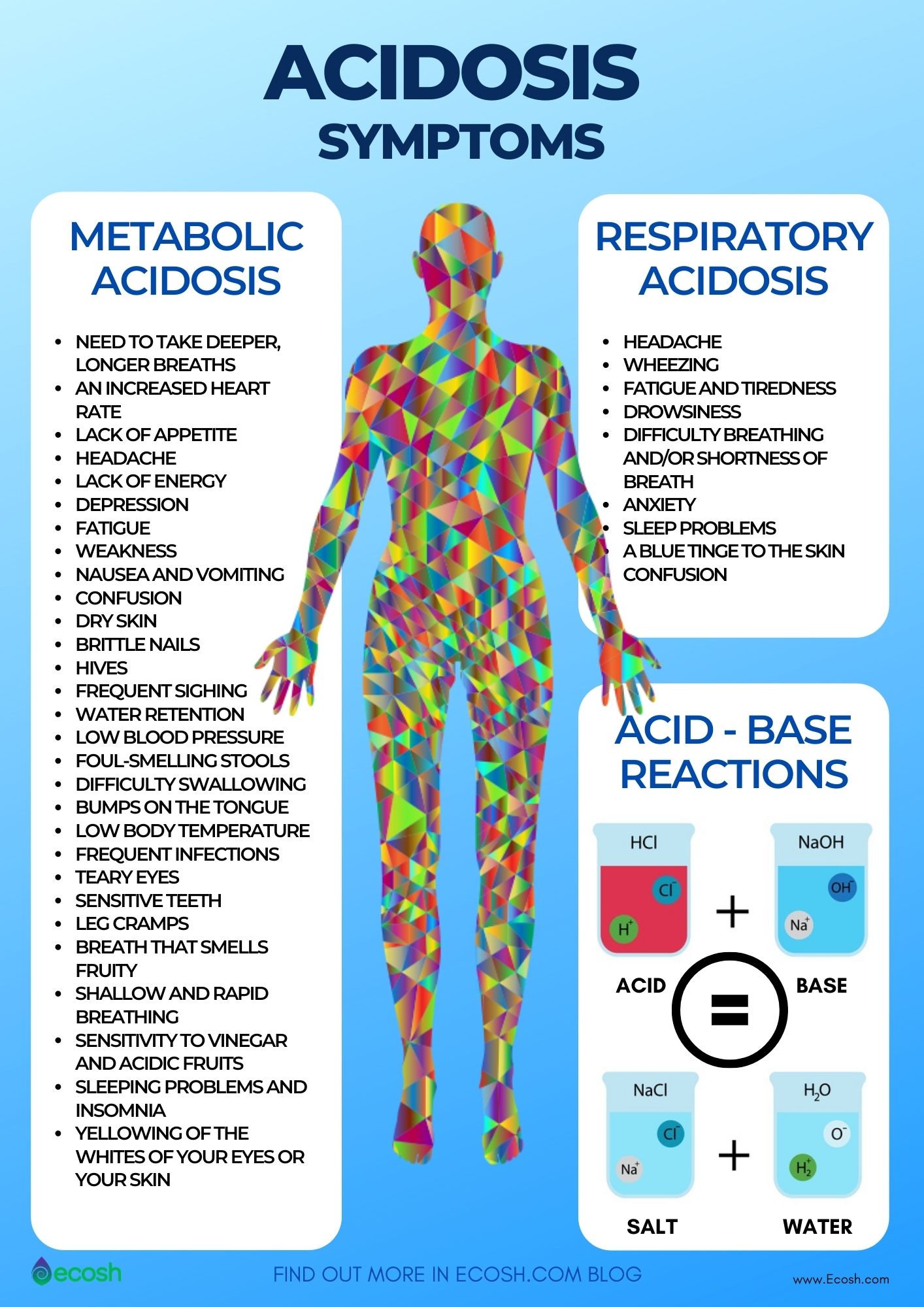Acidosis refers to a health condition in which there are too high levels of acid in your body fluids. For optimal health, your body needs to keep a balance between acidity and alkalinity. But if your body becomes too acidic (acidosis) or in contrast too alkaline (alkalosis, in which there is too much base in your body fluids) may lead to serious health issues and an overall feeling of ill health. Even more, severe acidosis can be fatal without treatment.
Normally, the kidneys and lungs are able to get rid of excess acid in your body. However, unhealthy diet, some lifestyle habits, certain health conditions and prescription drugs may increase the risk of having too much acid in your body and finally lead to severe acidosis.
Symptoms of acidosis may include headaches, sleeping problems, difficulty swallowing, bumps on the tongue, lack of energy, low body temperature, depression, frequent infections, dry skin, leg cramps, and more.
Eating more alkaline foods or taking certain supplements can help balance acidity in your body, but in some cases medications are needed. Here in this article we discuss the types, symptoms, causes, risk factors, complications, and natural treatment of acidosis (1, 3).

How to Know if You Have Too Much Acid in Your Body – What is pH and What Does The pH Scale Measure
When discussing balancing the acidity levels in your body, it’s firstly important to understand pH, as the acidity and alkalinity are measured by the pH scale. Overall, everything below 7.0 is acidic, and everything above 7.0 is alkaline. The pH value ranges from 0–14:
- 0.0–6.9: Acidic
- 7.0: Neutral
- 7.1–14.0: Alkaline (basic)
The perfect pH range for the human body is considered to be between 6.0 and 6.8. However, it’s important to note that pH differs significantly within your body. While certain parts of your body are alkaline, others are acidic. For example:
- Stomach: Due to hydrochloric acid (that is necessary to break down food), your stomach is highly acidic, as the pH is 2–3.5.
- Blood: On the contrary, your blood is always slightly alkaline, as the pH values range from 7.36 to 7.44.
- Urine: Normally, your urine pH values may range from 4.6 to 8.0. However, the normal value ranges may differ a bit between laboratories, so you should discuss with your provider about the meaning of your specific test results (6, 13, 14, 15).
Testing Your PH Levels at Home
One way to measure your pH value (the level of acid in the body) at home is to test your urine. To do this, you can use a simple PH test strip. For best test accuracy, you should perform the test first thing in the morning. However, some suggest to test the second urine of the day, as the first pee will be too acidic (because it dumps the wastes from the night before).
Urine test pH levels
- Lower than 6.5: Your body is considered acidic
- Between 6.5 and 7.5: These are optimal pH levels
- Higher than 7.5: Your body is considered alkaline (13, 15).
Types of Acidosis
The kidneys and lungs maintain the balance (proper pH level) of chemicals called acids and bases in the body. Acidosis occurs when acid builds up or when bicarbonate (a base) is lost, and is classified as metabolic or respiratory acidosis.
- Metabolic acidosis. Metabolic acidosis usually happens when your body stores or produces too much acid, when the kidneys are not able to remove this excess acid from the body or there is a loss of bicarbonate from your bloodstream.
- Respiratory acidosis. This type of acidosis occurs when there is too much CO2 (carbon dioxide, which is an acid) in your body, and when your body is unable to remove this excess carbon dioxide through breathing. Respiratory acidosis is sometimes also called hypercapnic acidosis and carbon dioxide acidosis (1).

Metabolic Acidosis Causes
Metabolic acidosis usually develops when your body stores or produces too much acid, when the kidneys are not able to remove this excess acid from the body or there is a loss of bicarbonate from your bloodstream (low levels of bicarbonate are those less than 22 millimoles per liter (mmol/l) and indicate that the blood is more acidic). Your kidneys also help maintain bicarbonate levels stable in the body.
You need a certain amount of bicarbonate in the blood to keep your body healthy. The typical Western diet generates 20-30 mEq of acid each day, and people with normal kidney function increase the production of ammonia to eliminate the acid. However, as kidney function decreases, the tubules lose the ability to eject this unwanted excess dietary acid.
There can be numerous causes why metabolic acidosis happens, and therefore the causes are sometimes grouped by the absence or presence of a normal anion gap. The anion gap test shows you how much acid is in your blood. Acid levels that are higher or lower than normal can signal a certain health condition. Anion gap is considered to be high if anion gap is over 12 mEq/L, and normal when anion gap is less than 11 mEq/L (2, 7).
Health Conditions and Lifestyle Habits That Can Lead to Metabolic Acidosis Include:
Lactic acidosis is a condition when lactic acid builds up in your bloodstream. For example, your body makes more lactic acid if you’re not getting enough oxygen for a long time during intense exercise.
Diabetic ketoacidosis, also called diabetic acidosis and DKA (e.g., Alcoholic, diabetic, or starvation) is a serious complication of diabetes that happens when your body produces excess levels of blood acids called ketones during uncontrolled diabetes.
Severe diarrhea. Hyperchloremic acidosis is a disease where acidosis (pH less than 7.35) happens due to the loss of too much sodium bicarbonate from the body, which can develop due to severe diarrhea.
Kidney disease or kidney failure (such as for example distal renal tubular acidosis, uremia or proximal renal tubular acidosis).
Drug-induced acidosis or poisoning that may be caused by certain drugs, treatment methods or other substances that can increase acidity in the body. These include substances, medications and treatment methods such as:
- Salicylates, ethylene glycol (found in antifreeze), methanol, aspirin
- Statins, beta-blockers, antiretrovirals, antibacterial drugs (such as trimethoprim)
- Acetazolamide
- Spironolactone
- Topiramate (medication used to treat epilepsy and prevent migraines)
- Organic acids, ethanol, paraldehyde, formaldehyde
- Carbon monoxide, cyanide, ibuprofen, metformin
- Propylene glycol (frequently found in infusions for certain intravenous medications used in the intensive care unit)
- Isoniazid, iron, phenelzine, tranylcypromine, valproic acid, verapamil
- Sulfates. These are chemicals often used as cleansing agents. Sulfates are found in household cleaners, detergents, and even shampoo we all use daily.
- Saline infusion
- Hyperalimentation
Severe dehydration.
Transient 5-oxoprolinuria that can happen due to long-term ingestion of high-doses of acetaminophen (frequently seen with sepsis, malnutrition, liver failure, or kidney failure).
Massive rhabdomyolysis (a dangerous condition caused by muscle breakdown and muscle death that can result from trauma, overexertion, toxic substances or disease).
Certain other health conditions such as for example Sjogren’s syndrome, biliary fistula, Addison disease.
Diet induced acidosis. Some foods may also increase acidity in the body leading to diet-induced acidosis. A diet might be acidic due to high levels of foods and drinks such as:

Respiratory Acidosis Causes
Respiratory acidosis (also hypercapnic acidosis and carbon dioxide acidosis) occurs when your body is unable to remove excess carbon dioxide (CO2), which then builds up in the body and increases acid levels in the blood. Ordinarily, the lungs remove carbon dioxide during breathing. But, sometimes your body can’t lose the excess CO2.
Causes That May Lead to Respiratory Acidosis Include For Example:
- Chronic airway problems or long term lung disorders such as asthma, chronic obstructive pulmonary disease (COPD), emphysema, or pneumonia.
- Stroke.
- Chest injury, deformed chest structure (such as for example kyphosis) or muscle weakness in the chest.
- Obesity, as it can interfere with expansion of the lungs and make breathing difficult.
- Sedative drugs misuse.
- Alcohol overuse.
- Obstructed airways (due to choking or other causes).
- Nervous system problems.
- The use of drugs that influence the central nervous system, like opioids.
- Conditions that influence the muscles involved in breathing, such as Guillain-Barre syndrome or muscular dystrophy.
- Acute pulmonary edema.
- Scoliosis.
- Cardiac arrest.
- Muscle weakness or other conditions that influence breathing or taking a deep breath.
- In addition, neuromuscular conditions such as myasthenia gravis, muscular dystrophy or multiple sclerosis (1, 2, 6, 10).

Metabolic Acidosis Symptoms
Sometimes, some individuals may not have any symptoms of metabolic acidosis. In those people who do, the common signs may include symptoms such as:
- An increased heart rate
- Lack of appetite
- Need to take deeper, longer breaths than usual
- Headache
- Lack of energy
- Depression
- Fatigue
- Weakness
- Nausea and vomiting
- Confusion
- Shallow and rapid breathing
- Sleeping problems and insomnia
- Yellowing of the whites of your eyes or your skin (jaundice)
- Dry skin
- Brittle nails
- Hives
- Frequent sighing
- Water retention
- Low blood pressure
- Foul-smelling stools
- Difficulty swallowing
- Sensitivity to vinegar and acidic fruits
- Bumps on the tongue
- Low body temperature
- Frequent infections
- Teary eyes
- Sensitive teeth
- Leg cramps
- In addition, breath that smells fruity (a sign of diabetic acidosis (ketoacidosis)) (2, 3, 6).
Respiratory Acidosis Symptoms
The symptoms of respiratory acidosis can depend on the underlying cause, but some common symptoms may include:
- Headache
- Wheezing
- Fatigue and becoming tired easily
- Drowsiness
- Difficulty breathing and/or shortness of breath
- Anxiety
- Sleep problems
- A blue tinge to the skin caused by a low level of oxygen in the blood
- Confusion (2).

Metabolic Acidosis Risk Factors and Risk Groups
Risk factors for metabolic acidosis include health conditions and lifestyle habits such as:
- A western diet high in animal protein and salt and low in fruits and vegetables
- Kidney problems
- Diabetes
- Certain diseases, such as Sjogren’s syndrome (2).
Respiratory Acidosis Risk Factors and Risk Groups
Some factors may increase the risk of developing respiratory acidosis. These risk factors include for instance:
- Asthma
- Having a surgery
- End stage COPD
- Smoking
- In addition, the use of opioids (2).

Acidosis Complications
Different types of acidosis can lead to many severe diseases and complications.
Metabolic acidosis may lead to complications such as:
- Cancer
- Worsened kidney damage
- Osteoporosis, that happens when your body makes too little bone or loses too much bone, or both, as bone is living tissue that is constantly being broken down and replaced. As a result, bones become weak and brittle and may break from a fall. Also other types of acidosis may lead to osteoporosis because if the lungs and kidneys are unable to eliminate excess acid, your body starts to take calcium from your bones, and then uses this calcium to neutralize the acid.
- Improper growth in children, because metabolic acidosis impedes the growth hormone.
- Muscle wasting or loss due to less protein in your body.
- High blood sugar.
- Endocrine system problems (the glands which produce hormones are not working like they should), which may cause insulin resistance and possibly diabetes.
- Inflammation (for instance swelling, redness, and pain).
- Amyloid accumulation (when protein builds-up in your body, it can hurt your joints, organs and brain).
- Increased risk of death (2, 8, 9).
Respiratory acidosis may lead to complications such as:
- Respiratory failure. Seek immediate medical help if you have a sudden difficulty in breathing or if your airway is obstructed.
- Poor organ function.
- Shock.
- Neurologic complications such as seizure and loss of consciousness.
- In addition, cardiovascular complications (11).

Metabolic Acidosis Prevention
If you want to lessen your risk of metabolic acidosis you can follow these tips:
- Hydrate. Try to drink plenty of pure water and other healthy fluids.
- Eat plenty of raw fruits and vegetables.
- Do not drink alcohol. Heavy drinking can rocket the buildup of lactic acid which causes metabolic acidosis
- Control of your diabetes. You can avoid ketoacidosis by managing your blood sugar levels (6).
Respiratory Acidosis Prevention
Although you can’t completely prevent respiratory acidosis, there are some things you can do to reduce your risk of developing the condition. Here’s what you can do:
- Do not smoke, as it can harm your lungs and make breathing less efficient.
- Never mix sedatives with alcohol.
- Stay at a healthy weight, as being overweight can affect your breathing (6).
Acidosis Treatment
The proper treatment method for acidosis depends on acidosis type and cause.
Metabolic Acidosis Treatment – How to Alkalize Your Body?
1. Sodium bicarbonate or sodium citrate pills
Bicarbonate (a form of carbon dioxide) is an alkaline (the opposite of an acid), and may therefore help balance the acid in the blood, as well as help prevent kidney disease from getting worse. Intravenous (IV) treatment with sodium bicarbonate is used to treat conditions that cause acidosis through bicarbonate (base) loss. This can occur due to diarrhea, some kidney conditions, and vomiting. However, do not attempt this type of treatment without the supervision of a doctor.
2. Supplements
Certain supplements may help balance the acidity and fight inflammation in your body if your metabolic acidosis is caused by an unhealthy diet. These supplements include for example:
- 9 SUPERFOODS SUPERGREEN – The best acid-base balancers in the body are green plants that also contain minerals such as magnesium, sodium, potassium, calcium, and so on. These all green medicinal forest plants are also contained in 9 SuperFoods. This supplement is rich in nutrients and has a high alkaline grade. 9 SuperFoods provides perfect support for the overall condition of the body and its digestive functioning, while contributing to cleansing the body and supporting the immune system.
- MINERALEX SEA WATER – The benefits of salts and soda are well-known when it comes to alkalizing the body. Purified seawater is also extremely high in minerals. Natural sea water in the Mineralex includes more than 70 minerals and trace elements, with the highest concentration of magnesium, sodium, and potassium. These minerals that are fast absorbing help to keep the body alkaline, provide energy for organs, tissues, and bones, and participate in producing body fluids and enzymes.
- DANDELION and TURMERIC – These anti-inflammatory plants help to reduce inflammation in your body and provide plenty of minerals that also help to eliminate pathological microorganisms such as viruses, fungi, parasites and harmful bacteria.
3. Healthy diet
Metabolic acidosis that is caused by unhealthy diet (diet induced metabolic acidosis) can be reversed with more alkaline forming foods. A diet that contains mostly plant-based protein, and plenty of fruit and vegetables (as fruit and vegetables can increase alkaline levels in your body) instead of animal protein can help prevent acid levels from climbing too high in the body. Alkaline forming foods include foods such as:
- Honey
- Raisins
- Corn
- Avocados
- Spinach
- Celery
- Cucumber
- Broccoli
- Pepper
- Figs
- Fresh fruits
- Fresh vegetables
- Soy products
- Coconut
- Molasses
- Lemon water. For instance, some suggest drinking lemon water every morning. You can make it by pressing the juice of half of the lemon with one cup of water (2, 3, 9, 12).
4. Treating your diabetes
Treatment for metabolic acidosis that is caused by uncontrolled diabetes involves first treating your diabetes and balancing blood sugar levels to help your body stop producing acids and remove acids. Treatment includes for example:
- Fluids
- Electrolytes (sodium, chloride, potassium)
- Diabetes medications
- Insulin (which works only if diabetes is causing the metabolic acidosis)
5. Hemodialysis
Dialysis is treatment for severe kidney problems or kidney failure that helps to remove wastes and excess acids from the blood.
6. Detoxification
If metabolic acidosis is caused by alcohol or drug poisoning, it is treated with detoxification, or in severe cases sometimes also with hemodialysis.
7. Inotropes and other medications
If your metabolic acidosis is caused by a heart problem, inotropes and other medications may help to improve heart function in conditions like heart failure and low blood pressure. These treatments improve oxygen flow to your body and lower blood acid levels (6).

Respiratory Acidosis Treatment
Treatment for respiratory acidosis will depend on the cause, as you must first treat the underlying condition, but the goal is likely to make breathing easier. Some treatment methods include for example:
- Antibiotics (for infection).
- Diuretics (for reducing excess fluid that affects the lungs and heart).
- Bronchodilators (for expanding the airways and relaxing the muscles that play a role in breathing).
- Corticosteroids (for reducing inflammation).
- In addition, mechanical ventilation (used only in severe cases) (2, 6, 10).
NB! The information provided here is for informational purposes only, so do not consider it as health care or medical diagnosis and treatment. Do not consider this information as a guarantee of the results you want to achieve. In addition, do not take this information as a replacement for the advice of your physician or other healthcare professional.
Even more, you should not use it to diagnose or treat a health problem. Before changing or discontinuing your existing medication, treatment, or care, or taking any dietary supplements, be sure to consult with your healthcare professional or doctor before starting any diet or program, or if you suspect you may have a medical condition.
Written by Maria-Helena Loik
Pictures: Pexels.com, Pixabay.com, Shutterstock.com
Sources:
- Acidosis: MedlinePlus Medical Encyclopedia
- Acidosis: Types, symptoms, complications, and treatment (medicalnewstoday.com)
- Signs of Poor pH Balance in the Body (livestrong.com)
- Metabolic acidosis – Wikipedia
- High Anion Gap Metabolic Acidosis – StatPearls – NCBI Bookshelf (nih.gov)
- Acidosis: Symptoms, Causes, and Treatment for Blood pH Levels (healthline.com)
- Metabolic Acidosis | National Kidney Foundation
- Examining the relationship between diet-induced acidosis and cancer (nih.gov)
- Metabolic acidosis – symptoms, complications & treatment – American Kidney Fund (AKF)
- Respiratory Acidosis: Types, Symptoms, and Causes (healthline.com)
- Respiratory acidosis (patient information) – wikidoc
- Dietary Treatment of Metabolic Acidosis in Chronic Kidney Disease (nih.gov)
- Are You Acidic or Alkaline? – Rose Wellness
- Acid-Base Homeostasis (nih.gov)
- Urine pH test (ucsfhealth.org)


